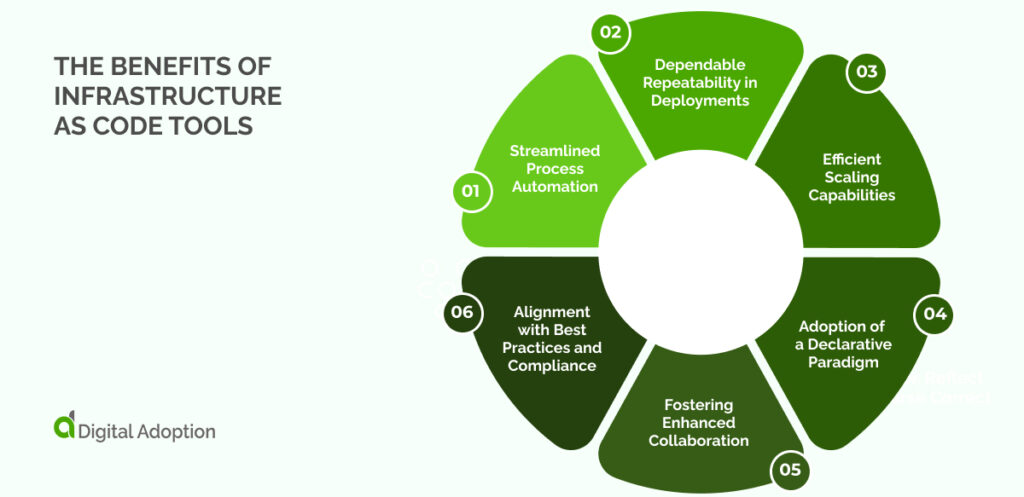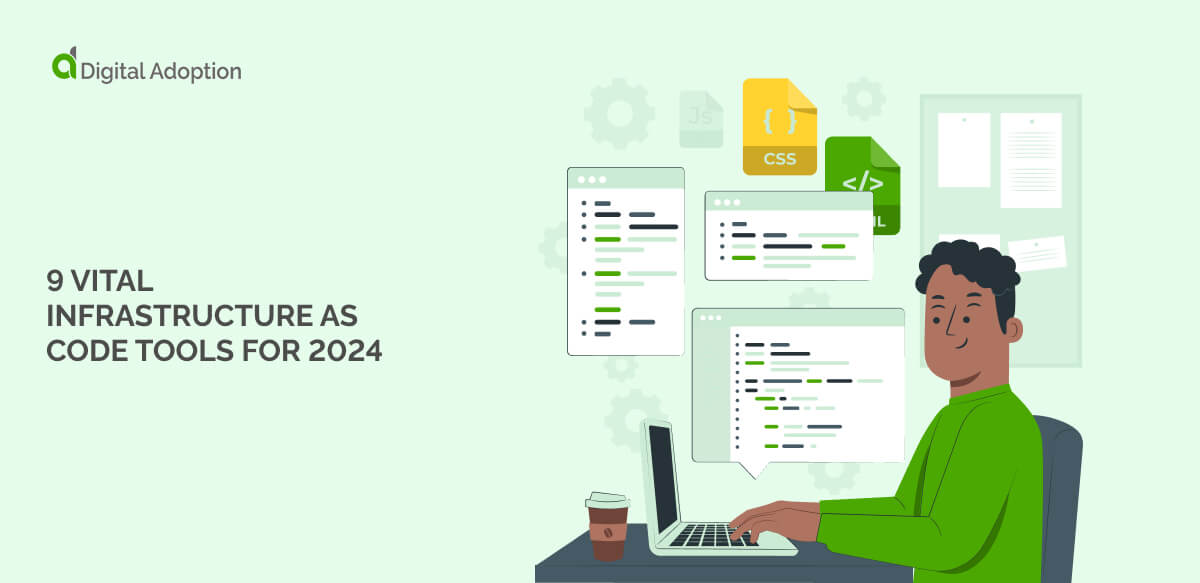Infrastructure as Code (IaC) tools equip DevOps and NetOps teams with a standardized approach for automating IT asset provisioning, configuration, and management, including networks, storage systems, servers, and virtual machines (VMs).
Teams responsible for infrastructure and operations consistently seek proficient methods to construct and deploy agile, flexible, and scalable applications across various industries. So, the surge in popularity of IaC tools can be attributed to two primary factors.
Initially, the escalating complexity of industry cloud platforms and architectures has rendered the manual management of these resources repetitive, time-intensive, labor-intensive, and susceptible to human error.
Moreover, it’s financially inefficient, as manual alterations need to be duplicated multiple times, diverting your engineering team’s time from more productive pursuits.
Thus, IaC tools can help you become a digitally mature enterprise by automatically managing infrastructure or overseeing existing cloud services and resources through code.
- What Are Infrastructure as Code Tools?
- What Are The Benefits Of Infrastructure as Code Tools?
- How Do You Implement Infrastructure as Code?
- Factors To Consider Before Purchasing Infrastructure as Code Tools
- 9 Vital Infrastructure as Code Tools For IT
- Utilize Infrastructure as Code Tools To Optimize IT Success
- Frequently Asked Questions
What Are Infrastructure as Code Tools?
Infrastructure-as-code tools facilitate the automated administration of IT infrastructure by using programming languages and automation instruments.
They diminish the necessity for manual processes and hardware manipulations during the deployment and configuration of servers, storage, databases, and networks.
In this way, an ideal IaC tool can help multi-cloud deployment, automatically detect problems, and is important for businesses undergoing digital transformation.
Documented configurations are preserved in version control systems, ensuring consistency and diminishing time lags.
IaC tools champion agility, scalability, and resilience, serving as a conduit to streamline DevOps and NetOps by orchestrating provisioning and sustaining repeatable processes.
What Are The Benefits Of Infrastructure as Code Tools?

IaC (Infrastructure as Code) tools allow you to manage, provision, and deploy infrastructure resources in an automated and repeatable manner.
This approach is becoming increasingly popular in the IT industry as it offers many benefits over traditional manual methods.
Advantages of adopting Infrastructure as Code tools include:
Streamlined Process Automation
IaC tools can enable comprehensive cloud infrastructure management with a lean team of engineers without straining your organizational budget.
Dependable Repeatability in Deployments
Infrastructure as Code tools provides a robust, tested, and automated framework to deploy and manage infrastructure daily, briskly and extensively.
Efficient Scaling Capabilities
Defining your infrastructure necessities in code facilitates a smoother transition when scaling up or down, thus ensuring IT efficiency by minimizing costs and time spent on repetitive tasks.
Adoption of a Declarative Paradigm
The implementation of IaC tools notably simplifies the provisioning of infrastructure. Once you integrate it with your workloads, there’s no necessity to sift through extensive documentation or perpetually adjust the state of your infrastructure.
The declarative paradigm of IaC allows you to specify the desired state while the controller ensures provisioning and sustains the system configuration accordingly.
Fostering Enhanced Collaboration
As IaC operates like code, it unveils expansive collaboration possibilities, which could be explored through version control systems or Cloud Engineering platforms, such as Pulumi.
Alignment with Best Practices and Compliance
Infrastructure as Code tools enables you to adhere to stringent availability prerequisites and security benchmarks while improving operational resilience.
Thus, IaC simplifies the modification and maintenance of configurations to align with your client’s requirements, which is often as straightforward as updating a singular value in the config file.
How Do You Implement Infrastructure as Code?
The strategies for writing or executing Infrastructure as Code include:
- Declarative (Functional) Approach: In a declarative strategy, the emphasis is placed on defining the desired end-state of the target, detailing “what” the actual configuration of the target should be.
Instead of outlining the steps to establish a server, it delineates the list of prerequisites or third-party software needed to configure the infrastructure or server.
- Imperative (Procedural) Approach: The imperative strategy specifies the commands that must be executed to realize the desired outcome. The critical approach transforms the infrastructure to comply with the specified result.
Subsequently, IaC can be implemented through two primary methods, namely ‘Push’ and ‘Pull’:
- ‘Push’ Method: This approach involves the controlling server pushing the configuration towards the specified system.
- ‘Pull’ Method: In contrast, the ‘Pull’ method necessitates the server, which requires configuration, to pull its respective configuration from the controlling server.
Factors To Consider Before Purchasing Infrastructure as Code Tools
Choosing the most suitable Infrastructure as Code (IaC) solution hinges on your specific infrastructure needs.
Several aspects need consideration when exploring and selecting IaC software:
Automation
Leveraging automation mitigates risks related to human errors stemming from manual deployment, configuration, and infrastructure management.
Automated deployments can be economical by minimizing mistakes, enhancing speed, and fine-tuning workloads.
Since numerous IaC tools provide automation features, evaluating different products based on their automation competencies is pivotal.
Scalability
Adhering to DevOps best practices implies the capability to swiftly and effortlessly scale up or down in response to fluctuating resource demands.
Opt for an Infrastructure as Code tool encompassing scalability functionalities like dynamic orchestration or autoscaling to ensure your environment is adequately resourced for present and prospective demands.
Certain IaC tools facilitate advanced scalability options like rolling or blue-green deployment strategies, enabling secure, uninterrupted updates without downtime or disturbances.
Cost
IaC tools confer notable cost advantages compared to manual infrastructure arrangement and upkeep.
Start by analyzing pricing structures across vendors and engage with free trials before settling on a solution.
Furthermore, explore potential licensing fees applicable for supplementary users or third-party applications.
Integration and Extensibility
In the quest for an IaC tool, prioritizing one that affords potent integration and extensibility options is crucial.
Ascertain that the IaC tool furnishes APIs for intertwining with external services and systems and maintains a library of plugins to amplify the product’s functionalities.
This affords you the adaptability to tailor your workflow to your explicit requirements. Moreover, robust extensibility options enable the crafting of custom integrations and connectors when necessary.
Security and Support
Numerous IaC solutions introduce inherent security features such as identity access management (IAM), encryption, and data loss prevention.
Next, opting for Infrastructure as Code tools that include dedicated customer service and technical support teams who can guide you through the implementation and adoption phases also proves advantageous.
Determine the nature of technical assistance they offer – live chat, email, phone support, or forums – ensuring you know whom to consult in the event of issues.
9 Vital Infrastructure as Code Tools For IT
When embarking on the journey to find your organization’s ideal Infrastructure as Code (IaC) solution, rather than gravitating towards the first seemingly suitable option, endeavor to unearth the one that genuinely aligns with your specific requirements.
To streamline your decision-making, here’s a glance at our top 9 Infrastructure as Code tools:
1. Terraform
HashiCorp Terraform, a premier open-source tool for infrastructure automation, focuses on configuring, provisioning, and managing infrastructure through code.
It utilizes a declarative approach, allowing users to orchestrate IaC across diverse infrastructure providers with a consistent workflow and execute a pre-execution check to validate configurations before any provisioning or updates.
2. AWS CloudFormation
AWS CloudFormation, embedded within the AWS cloud platform, furnishes a user-friendly method to adeptly provision and manage a conglomeration of related AWS and third-party resources, offering integration capabilities with other AWS resources and using YAML or JSON for models and templates.
3. Ansible
Developed by RedHat and revered for its simplicity, Ansible facilitates expedited, reliable, and coordinated application deployments, creating multiple secure and compliant environments and contributing to an organization’s innovative and strategic pursuits.
4. Google Cloud Deployment Manager
Google Cloud Deployment Manager, a deployment service by GCP, facilitates automated creation, configuration, and management of resources on the Google Cloud Platform, employing a declarative language and offering deployment previews and a user-friendly console interface.
5. Chef
Chef, notable in the IaC tool industry, employs a procedural language, necessitating users to specify the steps to achieve the desired state via its Ruby-based Domain Specific Language (DSL), thus enabling detailed configuration of applications and utilities.
6. Azure Resource Manager
Azure Resource Manager enables the deployment, maintenance, and monitoring of Azure resources.
Embracing a declarative template approach ensures consistent state maintenance across multiple deployments throughout the application development lifecycle.
7. Puppet
Puppet, a widely utilized open-source configuration management tool, employs a declarative approach within its Ruby-based DSL, dictating the desired configurations and allowing Puppet to determine the pathway to achieve them, facilitating quick and secure infrastructure delivery.
8. Pulumi
Pulumi distinguishes itself in the IaC tool landscape by offering substantial flexibility, supporting several programming languages, and retaining core concepts of established tools like Terraform.
Pulumi provides a host of automation options for deployment delivery, quality assurance via policies, auditing, and extensive identity control, all complemented by thorough documentation and accessible tutorials.
9. SaltStack
SaltStack, an open-source Python-based infrastructure configuration management tool, offers a straightforward solution for high-speed provisioning, deploying, and configuring infrastructure on any platform, focusing on automating and orchestrating infrastructure, security, and networks.
Utilize Infrastructure as Code Tools To Optimize IT Success
Infrastructure as Code (IaC) tools revolve around the administration and provisioning of infrastructure utilizing code, negating the need for manual procedures.
This involves crucial provisioning, deployment, configuration, and infrastructure orchestration.
Different tools play varied roles in setting up and managing infrastructure and applications within an environment. Two primary methodologies underpin the definition of IaC: declarative and procedural IaC.
The declarative methodology focuses on defining the desired end state of the system. In contrast, the procedural or imperative methodology provides a sequential guide on the actions needed to achieve the intended configuration.
IT initiatives such as the infrastructure-as-code model are poised to gain a competitive edge in the coming years. For those transitioning to IaC, acquiring apt tools from the get-go can smooth the journey.
Your optimal tool hinges on your unique needs and stipulations. It is advisable to embark on your research, scrutinize various tools, peruse reviews on neutral platforms, and seek product demonstrations or avail of free trials when possible.
Utilizing these tools enables you to automate and streamline the management of your infrastructure, affording you the bandwidth to concentrate on delivering unparalleled value to your clientele.
Frequently Asked Questions
What do Infrastructure as Code tools do?
Infrastructure-as-Code (IaC) tools streamline and regulate IT infrastructure by employing automated, reproducible processes. Cloud-based and on-premises data centers and infrastructure are overseen through specialized computing code.
These tools minimize the necessity for manual involvement in deploying and configuring servers, storage, databases, and networks.
What features should Infrastructure as Code tools have?
IaC tools ought to encompass the majority, if not all, of the subsequent features:
- Automation of IT infrastructure, applicable to both cloud and on-premises setups
- Management of infrastructure provisioning
- Oversight of configuration management
- Inclusion of scripting tools
- Coordination of container orchestration
- Deployment and configuration driven by templates
- Streamlined automated workflows
- Facilitation of application deployment
- Incorporation of version control
- Support for testing procedures
- Provision of dashboards and alert systems




![4 Best AI Chatbots for eCommerce [2025]](https://www.digital-adoption.com/wp-content/uploads/2025/03/4-Best-AI-Chatbots-for-eCommerce-2025-img-300x146.jpg)


![13 Digital Transformation Enablers [2025]](https://www.digital-adoption.com/wp-content/uploads/2025/02/13-Digital-Transformation-Enablers-2025-img-300x146.jpg)



![4 Best AI Chatbots for eCommerce [2025]](https://www.digital-adoption.com/wp-content/uploads/2025/03/4-Best-AI-Chatbots-for-eCommerce-2025-img.jpg)

